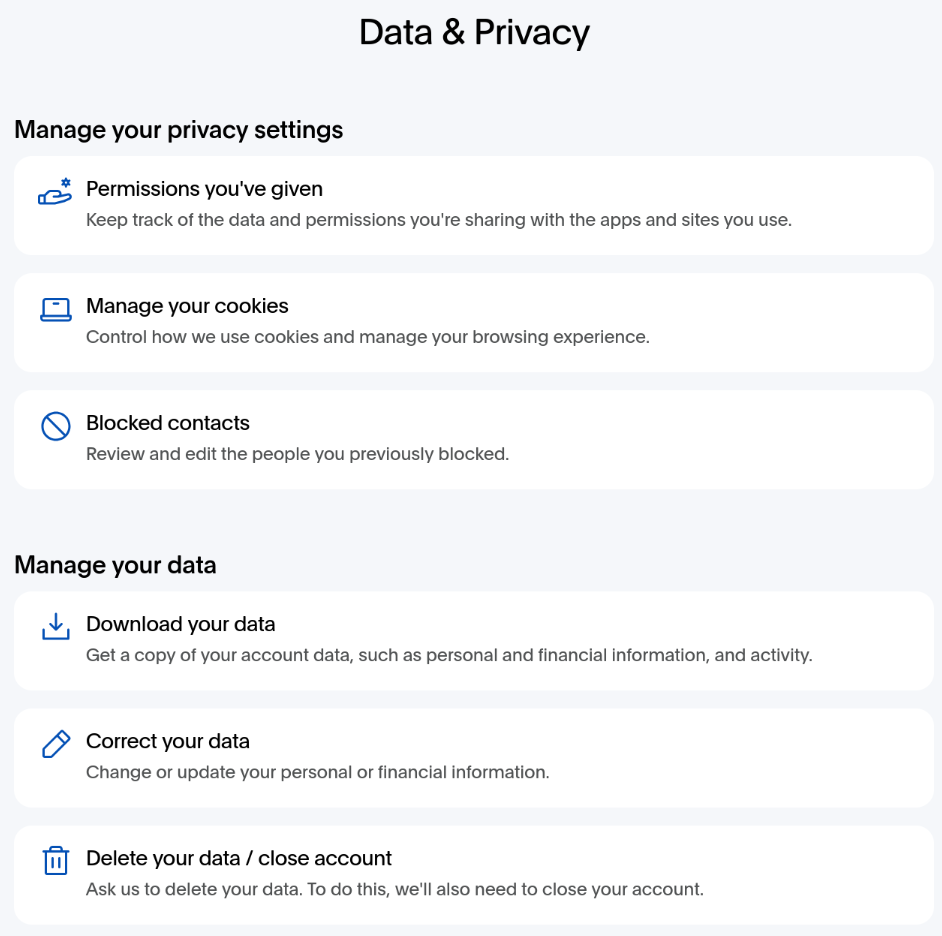


Might be worth having a look at this list of banking app compatibility: https://privsec.dev/posts/android/banking-applications-compatibility-with-grapheneos/


Yeah it’s a maybe, uLogger seems to let you choose which track you want to see. I presume the app lets you log to a specific track so you can have one for each person.
It might depend on what specific experience you’re looking for. For example, I log to Nextcloud and can view it there, but this is more of a “find my phone” plus tracking where I’ve been for myself (similar to Google Location History). While I’m sure I can set it up so others can see, it’s not really designed for it. It would also be a bit awkward as you’d have to log in to Nextcloud in a browser to see the locations (seems it’s possibly the same for uLogger).
I also run Home Assistant for home automation. I trigger automations off of my wife and my locations, but either of us can open the app and see at a glance where the other is (with pre-defined locations, such as “Home”, “School”, “@Dave’s Work”, etc, plus the ability to tap and see the exact location on a map).
That Home Assistant setup is much more useful for either of us seeing where the other is than I think the more dedicated tracking apps are, since they aren’t designed around sharing your location with others and that’s more of a side-function.


Just remember if you want to share location data with someone else, the app on your phone is only one half. You also need some sort of server ehere you install software for it to report to.
For uLogger that’s probably NextCloud with the PhoneTrack app installed, or OwnTracks.
There are companies that offer paid NextCloud hosting, but if you aren’t hosting it yourself you probably can’t say it meets your privacy requirement.


Ah nice! It’s only a month old but looks really good. It has a warning not to run it in production and not to trust it with your data but I’m definitely going to have a play.


Are you literally just wanting to see the location of family members?
If you’re a self-hoster there are options, and that’s pretty much the only way you can know it’s private.
Two that come to mind are:
The PhoneTrack NextCloud app. If you run Nextcloud you can install this in nextcloud, then install a location logger on the phones. I’m more familiar with Android which has options but from a search I think OwnTracks can send to Nextcloud and supports iOS and Android (someone reported their iOS success here).
Home Assistant let’s you see locations of people on a map that is tracked with the Home Assistant mobile app on Android/iOS.
I have found uLogger or the old PhoneTrack app (that connect to GPS on a schedule) to be more accurate than apps that rely on Google telling them when the location has changed (Home Assistant and I think Owntracks). But also much more of a battery drain.
So it depends how often you want the location to be updated. I find running uLogger or PhoneTrack on the phone actually makes Home Assistant get location updates much quicker(I run both for different reasons).


So, the good thing is, your emails are showing up and not disappearing into the ether like Microsoft.
We had this at work. B2B emails, going from paid Exchange customer to paid Exchange customer. Emails just disappeared without even showing up in junk. Sending email logs showed the email was accepted.
It says here it’s 100 total: https://help.kagi.com/kagi/plans/plan-types.htm
The Trial plan is limited to 100 total searches. This plan is suited for those interested in exploring Kagi and curious about paid search engines.


If it helps, most people don’t follow politics at all. And their votes are based on very little knowledge of what they are voting for.
I’m still a believer that if you put people in a room together instead of online, you’d get both sides of the aisle agreeing on 95% of things, once each side had a chance to explain their viewpoint (and made sure google was available to settle most disputes).


That’s not the point. A neutral stance VPN has all the anti-Nazis as customers, and all the Nazis. I would prefer anti-Nazi as well but I get that that a neutral stance means they can have more customers, something they need for economy of scale.
If they had stated their anti-trump stance then the freeze peach lemmy instances would probably have all their Nazis cancelling their proton subscriptions.
Honestly I hope all the cancellations on our side aren’t balanced by a bunch of Nazis signing up after seeing the comments.


That was probably their thought too. However, they have misjudged the Lemmy (and I think reddit) population on this, and I would argue that worse than the initial comment is the absolute lack of recognition (in follow up comments) that what they said could be taken as an endorsement of a government that is trying to actively harm a significant portion of the US Proton users.


I think that’s a different thing. That is a political stance but it’s not picking sides. People who want to organise Nazi rallys and people who need to communicate without getting attacked by Nazis both have reasons to use encrypted email. When you pick one over the other, you’ve cut the size of your userbase.
I found this: https://discuss.privacyguides.net/t/the-end-of-divest/23396/43
I’ve worked on this project a decade. That is a long time and I need to move on in life.
Sounds like a single person maintaining such a large project for such a long time means eventually you have had enough. I get that.
I think this is still not a citable claim. You link to the affirmative conclusion from a negative premise which includes that statement, but that page is explaining what that is. Your other page is using a claim to prove a different topic.
The problem is that Wikipedia is not where you prove things. You need to cite somewhere else that proves it, and you need to do it in an impartial way.
For example, saying that ‘“If you have nothing to hide you shouldn’t fear surveillance from the state” is a logical fallacy’ and citing the book makes Wikipedia have that stance.
But in contrast, you could say that 'Critics argue that the argument “If you have nothing to hide you shouldn’t fear surveillance from the state” is a logical fallacy" then cite the book, this way the critic is the one with the opinion and not Wikipedia.
More citations of more critics would probably help too.
I’m not an expert on Wikipedia by any means, but I do see why someone may have considered this statement not belonging on Wikipedia.
Wikipedia has some info here: https://en.m.wikipedia.org/wiki/Wikipedia:Neutral_point_of_view
Also see the links at the top of that page about “Verifiability” and “No Original Research” as these are the three key things needed to allow the statement.
Not that I disagree, but Wikipedia requires specific criteria for sources. I am not sure that a book about it being a logical fallacy meets that criteria any more than a book about parenting could be used to prove how to parent a child.
Are there other Wikipedia pages that claim things to be logical fallacies that could be used to see what the burden of proof is for this claim?
Normally we are a small enough market that it takes a while to be worth sorting out whether they comply with our laws.
One that comes to mind is that data can only be used for the purpose it’s collected, so I suspect adding this and opting people in would probably not be allowed. Grey area though, as it’s not clear to me (IANAL) whether updating TS & Cs and telling people would be enough to be considered getting user consent. I suspect not, though, I think it would need to be opt in so you’ve actively got user consent.
So, most likely it’s because our privacy laws are a bit stronger than their threshold, but also possibly because a small country of 5 million people (where paypal isn’t that common) isn’t worth spending lawyers on to work out if they are allowed to.
In my experience, sites aren’t implementing their own credit card payments. Paypal and Stripe are common, and there are a couple of local payment portals as well.
If it’s not one of those I probably wouldn’t use it, but in general it would never be the case that you can’t pay with a credit card, where as PayPal is probably an option 1/3 of the time.
PayPal didn’t come to my country until after online banking was already established, so I probably get a different experience. Banks here also issue (Visa) debit cards for free with a standard no fee bank account, so pretty much everyone has one. Debit cards being like a credit card in terms of paying online, but it uses money in your account.
Our biggest ebay-like site has their own payment portal for instant payments, done to copy what eBay did with paypal except you can’t use it outside of paying for things you bought on that site. But people are generally paying wuth a debit/credit card. And bank transfers are very common, but I wasn’t buying stuff online in 2001 so I’m not sure what it was like then.
Even today, paying with paypal in my country is far more likely to be a credit/debit card payment than a bank account one.
Personally, most stuff is in cloud storage. For local stuff I use syncthing.
But for the average person, I’d expect using iCloud, Google Drive, Onedrive, or Dropbox and then creating a shareable link for the other person.
I also can’t remember the last time I used a USB drive for anything other than installing an OS.
I think it depends why you want to bypass cloudflare, but realistically I don’t think you’re gonna be able to access those sites without going through cloudflare.
If you want to avoid accidentally stumbling into cloudflare, you could probably block their IP ranges. But of course that means you can’t access any cloudflare sites.
I stream from ethical services for some movies
What are these ethical movie streaming sources?
Is there an easy way to blur/censor my house without giving up my soul?
Have you tried this process? https://mashable.com/article/how-to-blur-your-house-on-google-street-view




I personally use a service like addy for less personal things, e.g. signing up for an account on a forum, signing up to newsletters, etc.
I use a custom domain with a catchall inbox for things I may need to contact someone over, or need a sense of legitimacy, e.g. buying something online, online account with doctor/insurance/government/etc, I give every service a slightly different email address so I can always tell where someone got it from (or who sold my data).
And one that I share with a limited set of friends and family.
I don’t see why you’d need a firstnamelastname.com domain, just find a common domain tld (com, net, etc) and buy something short and easily pronounceable or spellable in the off chance you have to give an email address IRL. When you want to put an email on a CV, use firstnamelastname@domain.com, that’s just as professional so long as your domain isn’t balls.com or something.